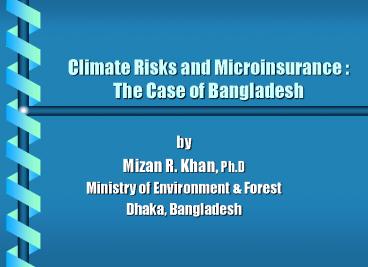Climate Risks and Microinsurance : The Case of Bangladesh - PowerPoint PPT Presentation
1 / 16
Title:
Climate Risks and Microinsurance : The Case of Bangladesh
Description:
CC scenarios developed for Bangladesh using GCM for different periods, with 1990 ... CC impacts likely to undo the achievements in econ growth rates ( 5%) & food ... – PowerPoint PPT presentation
Number of Views:26
Avg rating:3.0/5.0
Title: Climate Risks and Microinsurance : The Case of Bangladesh
1
Climate Risks and Microinsurance The Case of
Bangladesh
- by
- Mizan R. Khan, Ph.D
- Ministry of Environment Forest
- Dhaka, Bangladesh
2
Outline of Presentation
- Climate Risk Assessm in Bangladesh
- Concept Types of Microinsurance (MI)
- MI Practices in Bangladesh
- Gaps and Challenges
- Some Suggestions
3
Vulnerability of Bangladesh to CC Impacts
- Geographic socio-econ-demog features make
Bangladesh extremely vulnerable - located at the confluence of 3 mighty river
systems Ganges, Brahmaputra Meghna 92 of
their runoff originates outside its borders - long coast line (710 km)
- vast low-lying landmass/floodplains
- Highest pop density (pop growth rate 1.6)
- Nature-dependent agricultural practices
- Poor disadvantaged communities are most at risk
from multiple stresses including CC impacts
4
Climate Risk assessment in Bangladesh
- Risk is a combination of 2 factors
- Probability of climate hazard x Impacts/Effects
- Vulnerabilities, not risks, addressed by several
national intl assessments - Immediate warning ex-post disaster management
coping well developed in Bangladesh - CC scenarios developed for Bangladesh using GCM
for different periods, with 1990 as the base year
5
(No Transcript)
6
Projected Impacts of CC in Bangladesh
- Half a meter SLR will inundate 11 of territory
- Flash flooding will be more frequent
- River flooding will stay for longer periods
- Frequency of tropical cyclones storm surges
will increase - Agr productivity will be severely affected
- CC impacts likely to undo the achievements in
econ growth rates (gt 5) food self-sufficiency
during the last decade
7
Actual Impacts Risk Assessment
- Experienced gt 170 disasters during 1970-98,
putting the nation among the most hit in the
world - Ex-post evaluation of impacts done
- 500 sq km of coastal areas devastated by the 1991
cyclone, econ losses exceeded 1 bn - 1998 flood kept 2/3 of the country under water
for 2 months, econ losses incurred over 2 bn - Trends in natural hazards non-linear - so
predicting the likelihood of events in future is
difficult predicting effects based on
Forecasting by Analogy - Lack of capacity for ex-ante assessment of risks
8
Concept Types of Microinsurance
- MI is provision of insurance to low-income HHs,
which are vulnerable to multiple risks - Credit savings services are inadequate when HHs
are exposed to risks, causing losses that are
beyond their means - MI provides different types products for Life,
Health, Disability, Property, Agr (crop) etc.
9
MI Products under the MFI-NGOs
10
MI products under Commercial Insurers
11
Features of Commercial Non-Commercial MI
- Extremely limited scale of MI under both comm
non-comm insurers - life/loan insurance focused,
limited health MI growing under the MFI-NGOs - Policy amounts range bet 100 to 1000 only
- Existing MI delivery under Full-Service model
- MI products under commercial insurers targeted at
low income group, not the poor - Crop insurance under the Govt-owned insurer as an
extremely loosing concern now non-functional - MI under MFI-NGOs - kind of Self-Insurance, which
defeats the principle of wider risk-pooling
12
Gaps and Challenges
- No system of soc security for Self-employed (37
mn) Poor (3/4 engaged in Agr, Livestock
Fisheries) - Lack of capacity for early prediction of climate
hazards - Risks to assests and econ outputs of the poor not
covered under the existing MI systems - MFI-NGO MI Funds not sufficient to meet
large/unusual losses (some might be only book
reserves) - There is no system of mutual insurance
reinsurance - Huge demand for MI not yet effective due to
prevailing culture, lack of awareness costs
13
Gaps and Challenges (contd)
- So, scale of MI - stand most in the way
- Shortage of manpower for large-scale MI
- Risks of fraud moral hazard in MI of health
property - a big challenge - Admn transaction costs in MI heavy
- Lack of investment opportunities
- Lack of enabling environm - laws regulations
- Chance of loss from CC impacts - not adequately
calculable Catastrophic losses - insurable ? - Sustainability of MI under MFI-NGOs ?
14
Some Suggestions
- Integration of MI into existing fin services
Group, rather than Individual, MI will reduce
admn trans costs, moral hazard adv selection - Cross-subsidization (voluntary policy-based)
from rich to the poor to cover the total pop/area - Mass edn, awareness, RD promotion of skills
- Generation of Inf data base needed for MI
- Ensure transparency accountability of Insurers
- Involve local community opinion leaders in the
MI process
15
Some Suggestions (contd)
- Govt subsidy, with donor assistance to red Cs
- Provision of reinsurance by multinationals
- Promoting Mutual Insurance bet MFI-NGOs
- Partnership bet public, private orgs MFIs
- Starting with simple procedures products to
customize to HH needs - Appropriate caps, deductibles/coinsurance
- Strengthening institutional capability
- To ensure an enabling policy-regulatory framework
- To commission some studies on climate risk MI
- To organize a Workshop on MI CC Risks
16
- Thankyou































